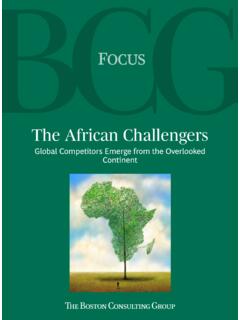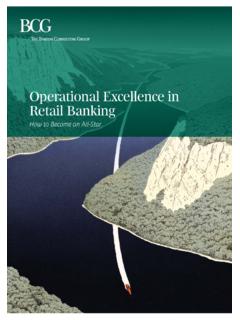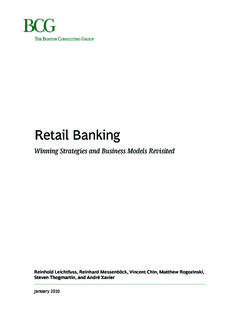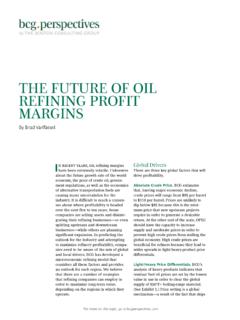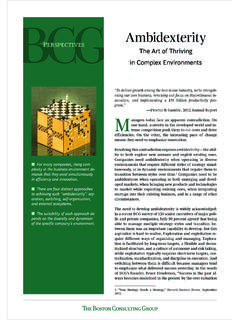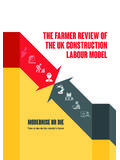Transcription of Bridging the Gap - BCG
1 Bridging the Gap Meeting the infrastructure Challenge with PubliC-Private PartnershiPsThe Boston Consulting Group (BCG) is a global management consulting firm and the world s leading advisor on business strategy. We partner with clients from the private, public, and not-for-profit sectors in all regions to identify their highest-value opportunities, address their most critical challenges, and transform their enterprises. Our customized approach combines deep in sight into the dynamics of companies and markets with close collaboration at all levels of the client organization. This ensures that our clients achieve sustainable compet itive advantage, build more capable organizations, and secure lasting results. Founded in 1963, BCG is a private company with 78 offices in 43 countries. For more information, please visit BCG Game-Changing ProgramWe are living in an age of accelerating change.
2 The old ways are rapidly becoming obsolete, and new opportunities are opening up. It is clear that the game is changing. At The Boston Consulting Group, we are optimistic: we think that the fundamental drivers of growth are stronger than they have ever been before. But to capitalize on this trend, leaders need to be proactive, to challenge the status quo, to make bold moves they need to change the game, too. The decisions they make now, and over the next ten years, will have an extraordinary and enduring impact on their own fortunes as well as on those of their organizations, the global economy, and society at large. To help leaders and to mark our fiftieth anniversary, BCG is pulling together the best ideas, insights, and ways to win to own the future. This publication is part of that the Gap Meeting the infrastructure challenge with Public-Private PartnershiPsFebruary 2013 | the boston consulting GroupMAr CO AIr OldIJeFFrey ChuAPhIlIPP GerBerTJAn JusTusrAFAel rIl O2 | Bridging the GapContents 3 IntroductIon 5 Public-Private PartnershiPs command growing attention the infrastructure gapforging the solution 9 a winning strategy for the Public sectorBest Practices throughout a Project s Life cyclecultivating an enabling environment 18 the Private-sector Piece of the Puzzleassess risk across the entire Portfolio of ProjectsManage risk in the Bidding and contract negotiation Phasesselect Partners that can fill critical needscontrol construction riskManage Operations and financial risksshape Public Perception 24 the way forward 25 for further reading 26 note to the readerthe boston
3 Consulting Group | 3 The need for infrastructure investment around the globe is climbing. in emerging markets, population growth, increasing urbanization, and rising per capita incomes are driving the demand for new roads, power stations, schools, and water delivery systems. in the developed world, including the united states, significant reinvest-ment in aging infrastructures is becoming urgent. but this need for infrastructure investment comes in the wake of a financial crisis that has severely constrained public budgets in many countries. the result: a staggering gap of approximately $1 trillion to $ trillion annually between demand and investment in partnerships (PPPs) will increasingly play a crucial role in Bridging the gap. these partnerships in which the private sector builds, controls, and operates infrastructure projects subject to strict government oversight and regulation tap private sources of financ-ing and expertise to deliver large infrastructure improvements.
4 When managed effectively, PPPs not only provide much needed new sources of capital, but also bring significant discipline to project selection, con-struction, and forming and managing PPPs, however, is no small feat. for one thing, governments, accustomed to focusing on delivering ser-vices, need to change their mindset and begin viewing these partner-ships as a product that they must develop, market, and sell to potential private-sector partners. at the same time, both the public and private sectors must overcome the challenges created by an inherent conflict between their respective objectives: the public sector wants to mini-mize total or overall economic costs and ensure the delivery of high-quality service, while the private sector aims to maximize not managed properly, that conflict can wreak havoc. in latin america, for example, many PPPs have had to be renegotiated, a de-velopment that often results in greater costs to taxpayers.
5 And in the united Kingdom, the government s first private-finance initiative was criticized for, among other things, failing to deliver good value for tax-payers stumbles, however, are not inevitable. drawing on ten years of experience in advising both governments and private-sector compa-nies, the boston consulting group has identified a series of best prac-tices that underlie successful best practices for the public sector apply to every stage in the for-mation and implementation of a PPP, from selecting and designing introduCtion4 | Bridging the Gapthe project, to developing a regulatory structure and a transaction process, to supervising the concessionaire (the private company enti-tled to temporarily own and operate the asset) throughout the proj-ect s life cycle. in addition, public-sector leaders must take concrete steps to cultivate an environment in which PPP projects can flourish, such as securing the right project-management expertise within the government and employing policies that support a vibrant industry of engineering and construction companies as well as other private-sec-tor partners, such as , the private sector needs to develop a sophisticated ap-proach to managing the myriad risks that PPPs present, from the po-litical risks associated with a change in government policy to the risk of setbacks in financing or construction in both the public sector and the private sector who follow the steps outlined in this report will significantly increase the odds of making PPP projects a success.
6 And as the demand for infrastruc-ture investments rises while public funding remains constrained, well-designed PPPs will emerge as a critical tool for helping coun-tries around the world advance their growth prospects and raise the standard of living for their boston consulting Group | 5 Government leaders in many parts of the world are taking a greater interest in public-private partnerships. such partner-ships in which the private sector builds, controls, and operates infrastructure projects with strict government oversight and regula-tion tap private sources of financing and expertise to deliver large infrastructure improvements. (see the sidebar defining a Public-Private Partnership. ) this heightened interest is particularly keen in emerging markets where, aside from a dip in activity following the 2008 financial crisis, the number of PPPs has continued to climb over the past decade.
7 In the developed world including the united Kingdom, canada, and australia interest continues to grow in using PPPs to boost infrastructure invest-ment. still, political concerns, including a negative view of infrastructure privatization in some markets and sectors, have limited the use of PPPs in many other developed infrastructure Gapthe need for significant infrastructure spend-ing is mounting worldwide. according to a bcg analysis (which is partly based on an as-sessment by the organisation for economic co-operation and development), the demand for investment in areas such as energy, trans-portation, water, waste, and social infrastruc-ture (such as hospitals and schools) is expect-ed to hit an average of $4 trillion annually between 2011 and -private partnerships Command GrowinG attention the level of private involvement in infrastructure projects varies, but increas-ingly, investment and operational respon-sibility and risk are being transferred to private partners via operations and maintenance contracts, leases, conces-sions, and privatizations.
8 For the purposes of this report, we define public-private partnerships rather narrowly. We charac-terize PPPs as relationships in which construction and operation are bundled, private companies have temporary control of assets, and both public and private entities share some degree of see eduardo engel, ronald fischer, and alexander galetovic, the Basic Public finance of Public-Private Partnerships, cowles foundation Discussion Paper no. 1618, January a PubliC-Private PartnershiP6 | Bridging the GapPowerful forces are behind this surge in de-mand. the key drivers in emerging markets are a growing population, urbanization, and rising per capita incomes. in the developed world, continued increases in travel and the flow of goods are straining aging transporta-tion infrastructures, which are often poorly maintained and already in need of upgrades to meet heightened safety and quality re-quirements.
9 At the same time, a push toward low-carbon economies and energy indepen-dence in developed markets is driving invest-ments in renewable-power generation, grid infrastructure, and oil and gas exploration and construction activity, mean-while, is not keeping pace with the demand. in fact, the rate of infrastructure spending relative to gdP has declined in most devel-oped countries over the past 40 years. and between 2008 and 2010, infrastructure invest-ments around the world averaged only $ trillion annually, according to a bcg analysis based on data from ihs. (see exhibit 1.) the largest spending in that period occurred in asia and was driven by the booming and ur-banizing economies of china and india, with electricity, road, and railway investments ac-counting for just over 60 percent of the total. the upshot: an estimated gap of $1 trillion to $ trillion annually between demand and investment in infrastructure between now and 2030.
10 (see exhibit 2.)this shortfall has significant real-world impli-cations. major repercussions result when criti-cal infrastructure systems fail, such as when bottlenecks occur because ports cannot han-dle shipping demand and when power sys-tems cause frequent blackouts that cripple lo-cal manufacturers. Key business leaders around the globe have been quite public about their dissatisfaction with the state of their respective countries infrastructures. their concern reflects the fact that a subpar The largest infrastructure investments areconcentrated in AsiaElectricity, roads, and railways constitute morethan 60 percent of global infrastructure investment1,0003,0002,0000 Oceania60 MiddleEastandAfrica120 CentralandEasternEuropeandRussia 160 LatinAmerica210 NorthAmerica510 WesternEurope640 Asia990 Total2,690$billionsPublicPrivateAverage annual investments in infrastructure2008 201019%24%4%8%6%37%2%$billions3,0002,000 1,0000 Global2,69017%15%3%4%30%7%6%18%Social infrastructureWater and wasteOil and gas transmissionand storageElectricityPortsAirportsRailwaysR oadsSources: Ihs, World economic Forum, The World Bank Group, International Monetary Fund, european Investment Bank, Vnesheconombank, Morgan stanley, deutsche Bank, ICBC, CIBC rosstat, u.

